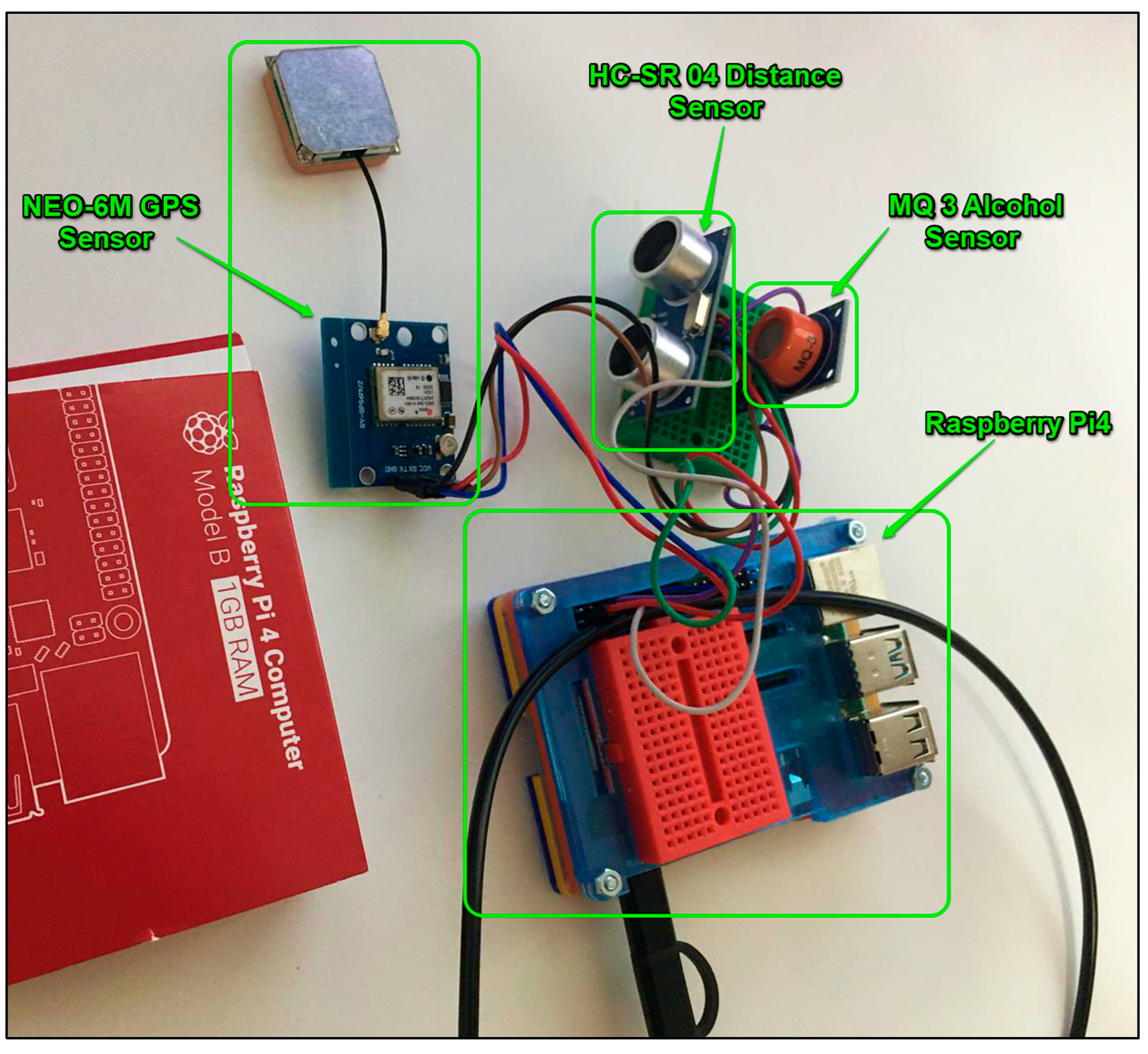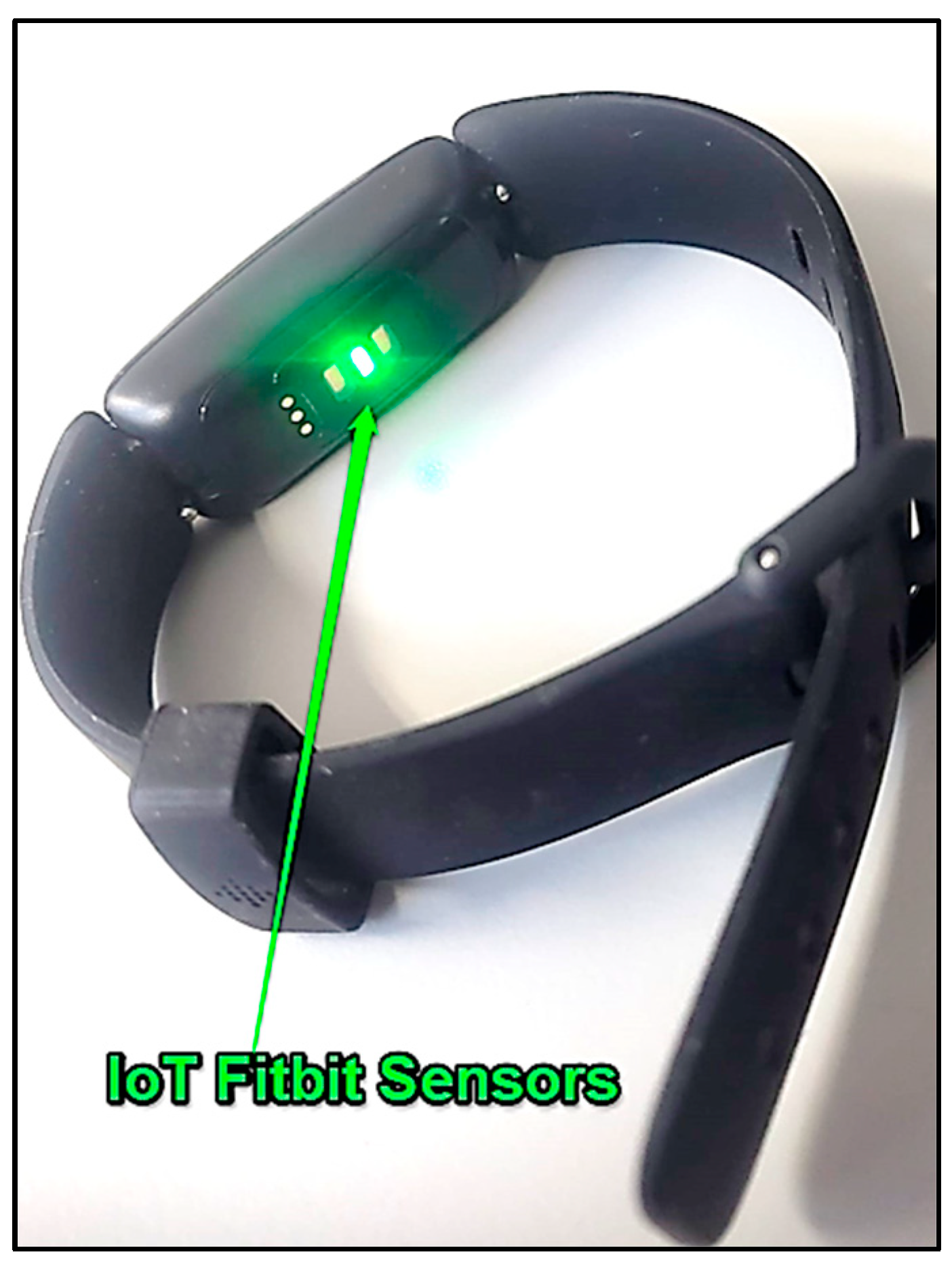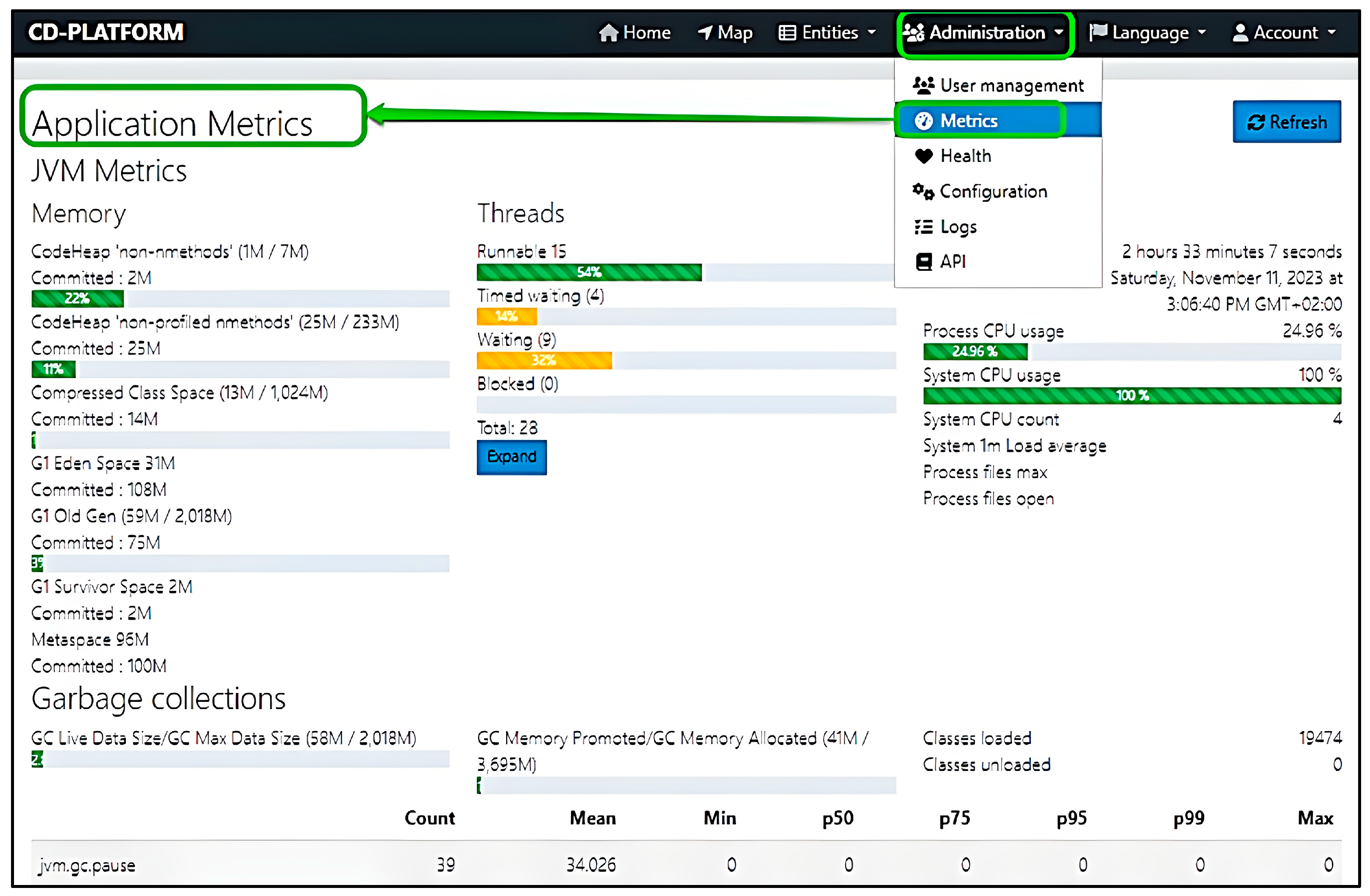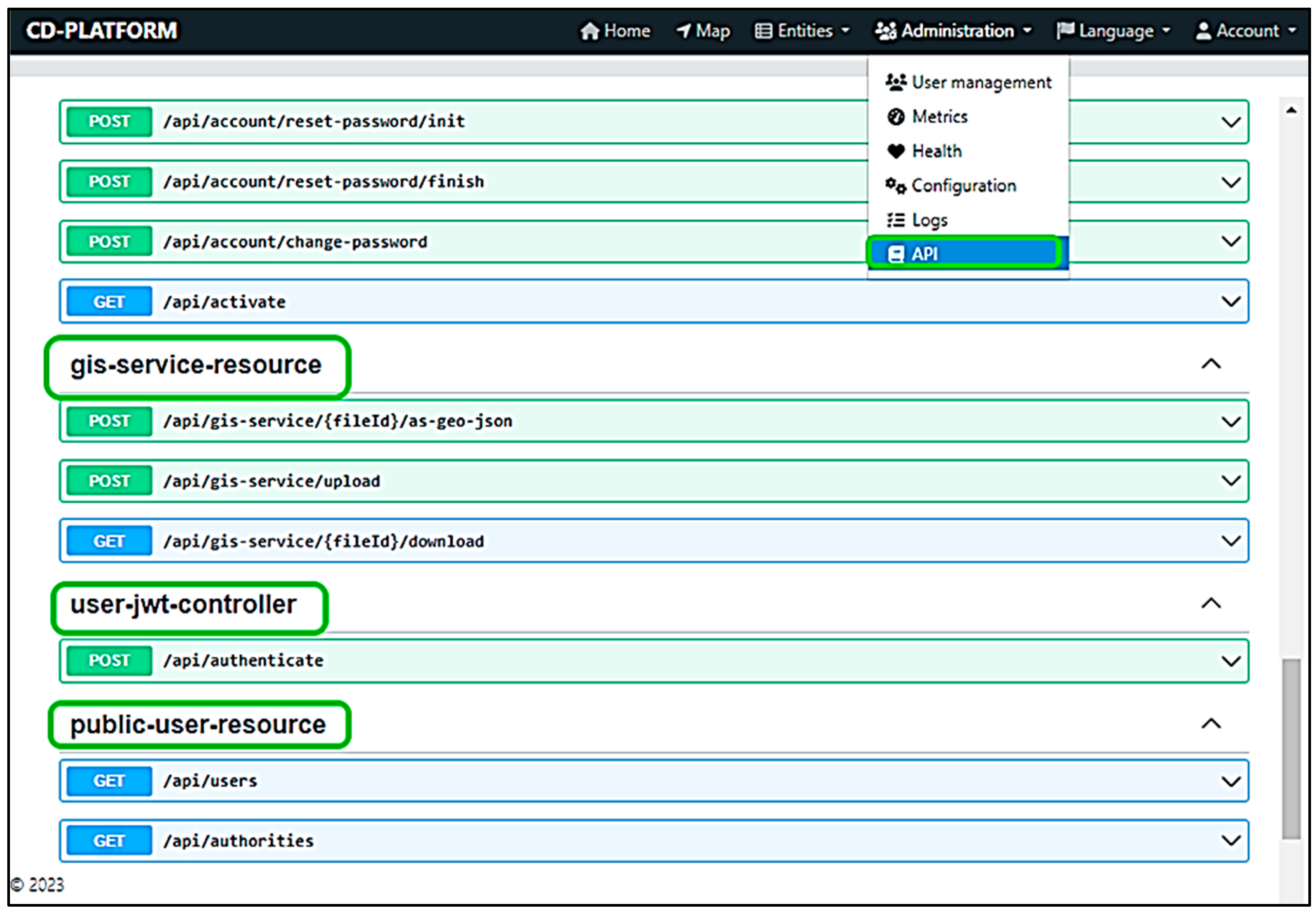A Blockchain-Based System for Monitoring Sobriety and Tracking Location of Traffic Drivers
Abstract
1. Introduction
- (i)
- A dual-channel monitoring strategy that combines breath-based alcohol sensing with physiological indicators (heart rate and SpO2), thereby increasing robustness against environmental interference and sensor limitations;
- (ii)
- Real-time blockchain integration at the microcontroller level, with hashes computed before transmission, ensuring tamper-proof integrity;
- (iii)
- A modular, scalable design enabling interoperability with existing vehicular and IoT infrastructures.
2. System Description
2.1. Block Diagram
2.2. Hardware and Software Setup
2.2.1. Modular Sensor Battery
2.2.2. The IoT FitBit Smart Band Bracelet
2.2.3. The DC Platform
2.3. Confidentiality of Information and Blockchain Technology
- (i)
- The Modular Sensor Battery (MSB) and IoT FitBit Smart Band (IFSB), which generate and submit hashed sensor readings;
- (ii)
- The Data Collection Platform (DC Platform), which queries and cross-validates data integrity;
- (iii)
- Potential third-party verifiers such as law enforcement agencies, insurance providers, or road safety organizations, which can independently validate sensor authenticity without accessing sensitive raw data.
- The authenticity of all recorded measurements (alcohol levels, heart rate, SpO2, GPS location);
- The secure origin of data transmissions—validated through authorized wallet addresses;
- Long-term traceability and auditability without compromising user privacy.
3. Experimental Setup
3.1. Data Acquisition and Parameters
3.2. Experimental Conditions
- (i)
- Alcohol concentration in the exhaled air, recorded in parts per million (ppm) using the MQ-3 alcohol sensor, and coded as .
- (ii)
- Heart rate, recorded in beats per minute and labeled .
- (iii)
- Blood oxygen saturation, expressed as a percentage and labeled .
4. Results and Analysis
- Real-time detection of alcohol exposure via the MQ-3 sensor.
- Continuous, non-invasive physiological monitoring using FitBit 3.
- Automatic fallback to physiological data when breath-based readings become unreliable.
- Seamless integration with a blockchain verification layer ensuring tamper-proof storage and public auditability.
5. Conclusions
Author Contributions
Funding
Data Availability Statement
Conflicts of Interest
References
- Drunk Driver Detection Using Multiple Non-Invasive Biosignals. Available online: https://www.mdpi.com/1424-8220/25/5/1281 (accessed on 8 April 2025).
- Hoaken, P.N.S.; Giancola, P.R.; Pihl, R.O. Executive cognitive functions as mediators of alcohol-related aggression. Alcohol Alcohol. 1998, 33, 47–54. [Google Scholar] [CrossRef]
- Ansari, H.R.; Kordrostami, Z.; Mirzaei, A. In-vehicle wireless driver breath alcohol detection system using a microheater integrated gas sensor based on Sn-doped CuO nanostructures. Sci. Rep. 2023, 13, 7136. [Google Scholar] [CrossRef]
- Drunk Driving | Statistics and Resources | NHTSA. Available online: https://www.nhtsa.gov/risky-driving/drunk-driving (accessed on 28 March 2025).
- Farooq, H.; Altaf, A.; Iqbal, F.; Galán, J.C.; Aray, D.G.; Ashraf, I. DrunkChain: Blockchain-Based IoT System for Preventing Drunk Driving-Related Traffic Accidents. Sensors 2023, 23, 5388. [Google Scholar] [CrossRef]
- Soner, S.; Litoriya, R.; Pandey, P. Integrating Blockchain Technology with IoT and ML to Avoid Road Accidents Caused by Drunk Driving. Wirel. Pers. Commun. 2022, 125, 3001–3018. Available online: https://link.springer.com/article/10.1007/s11277-022-09695-x (accessed on 8 April 2025). [CrossRef]
- Jones, A.W. The Relationship between Blood Alcohol Concentration (BAC) and Breath Alcohol Concentration (BrAC): A Review of the Evidence. Road Saf. Web Publ. 2010, 15, 1–43. [Google Scholar]
- Abu Al-Haija, Q.; Krichen, M. A Lightweight In-Vehicle Alcohol Detection Using Smart Sensing and Supervised Learning. Computers 2022, 11, 121. [Google Scholar] [CrossRef]
- Ferguson, S.; Zaouk, A.; Strohl, C. Driver Alcohol Detection System for Safety (DADSS). Background and Rationale for Technology Approaches; SAE Technical Paper 2010-01-1580; SAE International: Washington, DC, USA, 2010. [Google Scholar] [CrossRef]
- Radeisen, E.; Shao, H.; Hesser, J.; Pitz, M.; Wang, W.; Kolditz, O. A heterogeneous material model for dilatancy-controlled gas flow in saturated bentonite. In Proceedings of the 8th International Clay Conference, Nancy, France, 13–16 June 2022. [Google Scholar] [CrossRef]
- Reina, J.D.M.; Sanguino, T.J.M. Decentralized and Secure Blockchain Solution for Tamper-Proof Logging Events. Futur. Internet 2025, 17, 108. [Google Scholar] [CrossRef]
- Aleisa, M.A. Blockchain-Enabled Zero Trust Architecture for Privacy-Preserving Cybersecurity in IoT Environments. IEEE Access 2025, 13, 18660–18676. [Google Scholar] [CrossRef]
- Karpinski, M.; Kuznetsov, O.; Oliynykov, R. Security, Privacy, Confidentiality, and Trust in the Blockchain: From Theory to Applications. Electronics 2025, 14, 581. [Google Scholar] [CrossRef]
- Venkatesh, B.; Kapri, P. Usage of Blockchain Technology for Tamper-Proof Audit and Managing Insurance Process. ResearchGate. Available online: https://www.researchgate.net/publication/375058853_Usage_of_Blockchain_Technology_for_Tamper-Proof_Audit_and_Managing_Insurance_Process (accessed on 6 June 2025).
- Ferguson, S.A.; Draisin, N.A. Strategies for accelerating the implementation of non-intrusive alcohol detection systems in the vehicle fleet. Traffic Inj. Prev. 2021, 22, 13–19. [Google Scholar] [CrossRef] [PubMed]
- Tavallaie, R.; De Almeida, S.R.M.; Gooding, J.J. Toward biosensors for the detection of circulating microRNA as a cancer biomarker: An overview of the challenges and successes. Wiley Interdiscip. Rev. Nanomed. Nanobiotechnology 2015, 7, 580–592. [Google Scholar] [CrossRef]
- O’loughlin, D.; Oliveira, B.L.; Elahi, M.A.; Glavin, M.; Jones, E.; Popović, M.; O’halloran, M. Parameter Search Algorithms for Microwave Radar-Based Breast Imaging: Focal Quality Metrics as Fitness Functions. Sensors 2017, 17, 2823. [Google Scholar] [CrossRef]
- De Donno, M.; Tange, K.; Dragoni, N. Foundations and Evolution of Modern Computing Paradigms: Cloud, IoT, Edge, and Fog. IEEE Access 2019, 7, 150936–150948. [Google Scholar] [CrossRef]
- Scuotto, V.; Ferraris, A.; Bresciani, S.; Del Giudice, M. Internet of Things: Applications and challenges in smart cities: A case study of IBM smart city projects. Bus. Process. Manag. J. 2016, 22, 357–367. [Google Scholar] [CrossRef]
- Bettella, G.; Zamboni, R.; Pozza, G.; Zaltron, A.; Montevecchi, C.; Pierno, M.; Mistura, G.; Sada, C.; Gauthier-Manuel, L.; Chauvet, M. LiNbO3 integrated system for opto-microfluidic sensing. Sensors Actuators B Chem. 2019, 282, 391–398. [Google Scholar] [CrossRef]
- Ouaddah, A.; Elkalam, A.A.; Ouahman, A.A. FairAccess: A new Blockchain-based access control framework for the Internet of Things. Secur. Commun. Networks 2016, 9, 5943–5964. [Google Scholar] [CrossRef]
- Karunarathne, S.M.; Saxena, N.; Khan, M.K. Security and Privacy in IoT Smart Healthcare. IEEE Internet Comput. 2021, 25, 37–48. [Google Scholar] [CrossRef]
- Haseeb, S.; Ansari, U.; Ali, H. 500.22 Using Machine Learning Extreme Gradient Boosting Model to Predict Major Adverse Cardiovascular Events: A Systematic Review. JACC: Cardiovasc. Interv. 2024, 17, S55. [Google Scholar] [CrossRef]
- Esposito, M.; Palma, L.; Belli, A.; Sabbatini, L.; Pierleoni, P. Recent Advances in Internet of Things Solutions for Early Warning Systems: A Review. Sensors 2022, 22, 2124. [Google Scholar] [CrossRef]
- Davoli, L.; Martalò, M.; Cilfone, A.; Belli, L.; Ferrari, G.; Presta, R.; Montanari, R.; Mengoni, M.; Giraldi, L.; Amparore, E.G.; et al. On Driver Behavior Recognition for Increased Safety: A Roadmap. Safety 2020, 6, 55. [Google Scholar] [CrossRef]
- Yang, Y.; Jiang, J.; Zeng, J.; Chen, Z.; Zhu, X.; Shi, Y. CH4, C2H6, and CO2 Multi-Gas Sensing Based on Portable Mid-Infrared Spectroscopy and PCA-BP Algorithm. Sensors 2023, 23, 1413. [Google Scholar] [CrossRef]
- Llobet, E.; Brezmes, J.; Vilanova, X.; Sueiras, J.E.; Correig, X. Qualitative and quantitative analysis of volatile organic compounds using transient and steady-state responses of a thick-film tin oxide gas sensor array. Sensors Actuators B Chem. 1997, 41, 13–21. [Google Scholar] [CrossRef]
- Wei, H.; Xue, Q.; Li, A.; Wan, T.; Huang, Y.; Cui, D.; Pan, D.; Dong, B.; Wei, R.; Naik, N.; et al. Dendritic core-shell copper-nickel alloy@metal oxide for efficient non-enzymatic glucose detection. Sensors Actuators B Chem. 2021, 337, 129687. [Google Scholar] [CrossRef]
- Chukleang, T.; Jandaeng, C. Security Enhancement in Smart Logistics with Blockchain Technology: A Home Delivery Use Case. Informatics 2022, 9, 70. [Google Scholar] [CrossRef]
- 50 of the most important Raspberry Pi Sensors and Components. Tutorials for Raspberry Pi. Available online: https://tutorials-raspberrypi.com/raspberry-pi-sensors-overview-50-important-components/ (accessed on 28 March 2025).
- Gavrilă, M.; Murariu, M.G.; Bărbuță, D.E.; Tărniceriu, D. Development of a Modular Sensor Battery Integrated with a Data Collection Platform for Alcohol Level Detection and Driver Geolocation. In Proceedings of the 15th International Conference on Communications (COMM), Bucharest, Romania, 3–4 October 2024; p. 6. [Google Scholar] [CrossRef]
- Anthony, M.; Varia, R.; Kapadia, A.; Mukherjee, M. Alcohol Detection System to Reduce Drunk Driving. Int. J. Eng. Res. Technol. 2021, 9, 360–365. [Google Scholar] [CrossRef]
- Guan, Q.; Fan, C.; Chen, G.; Chen, C. Performance Evaluation of BDS/GPS Combined Single Point Positioning with Low-cost Single-Frequency Receiver. J. Indian Soc. Remote Sens. 2021, 49, 2847–2861. [Google Scholar] [CrossRef]
- Paterson, A.S.; Raja, B.; Mandadi, V.; Townsend, B.; Lee, M.; Buell, A.; Vu, B.; Brgoch, J.; Willson, R.C. A low-cost smartphone-based platform for highly sensitive point-of-care testing with persistent luminescent phosphors. Lab a Chip 2017, 17, 1051–1059. [Google Scholar] [CrossRef] [PubMed]
- Mekki, K.; Bajic, E.; Chaxel, F.; Meyer, F. A comparative study of LPWAN technologies for large-scale IoT deployment. ICT Express 2019, 5, 1–7. [Google Scholar] [CrossRef]
- Upton, E.; Halfacree, G. Getting Started with the Raspberry Pi. In Raspberry Pi® User Guide; John Wiley & Sons: Hoboken, NJ, USA, 2016; pp. 23–42. [Google Scholar] [CrossRef]
- Gavrilă, M.; Murariu, M.-G.; Ambrozie, R.-E.; Tărniceriu, D. Monitoring Health Traffic Participants Using a IoT Smart Band Integrated with a Data Collection Platform Secured with Blockchain. In Proceedings of the E-Health and Bioengineering Conference (EHB), Iași, Romania, 14–15 November 2024; p. 4. [Google Scholar] [CrossRef]
- Wisana, I.D.G.H.W.; Nugraha, P.C.; Amrinsani, F.; Sani, F.F.; Anwar, Y.I.; Palanisamy, S. Smartband for Heartbeat and Oxygen Saturation Monitoring with Critical Warning to Paramedic via IoT. J. Teknokes 2022, 15, 161–166. [Google Scholar] [CrossRef]
- Nugroho, E.A.; Herlambang, R.; Juhaeriyah, J.; Wulandari, R. Design and Development of Smart Bracelet System for Heart Health Monitoring Based on Internet of Things (IoT). Malays. J. Sci. Adv. Technol. 2024, 4, 217–221. [Google Scholar] [CrossRef]
- Gavrilă, M.; Murariu, M.G.; Bărbuță, D.E.; Mihăilescu, E.; Tărniceriu, D. Enhancing Driver Safety through A Data Collection Platform. In Proceedings of the 16th International Conference on Electronics, Computers and Artificial Intelligence (ECAI), Iași, Romania, 27–28 June 2024; p. 8. [Google Scholar] [CrossRef]
- Gavrilă, M.; Fotache, M.; Bărbuţă, D.-E.; Alexandrescu, A.; Murariu, M.-G.; Ambrozie, R.-E.; Tărniceriu, D. Sensor Data Analysis in a Real-Time IoT and Blockchain-Based System for Monitoring Driver Alcohol Levels. In Proceedings of the 2024 International Symposium on Electronics and Telecommunications (ISETC), Timișoara, Romania, 7–8 November 2024; p. 6. [Google Scholar] [CrossRef]
- Eenmaa-Dimitrieva, H.; Schmidt-Kessen, M.J. Creating markets in no-trust environments: The law and economics of smart contracts. Comput. Law Secur. Rev. 2019, 35, 69–88. [Google Scholar] [CrossRef]
- Bărbuţă, D.-E.; Alexandrescu, A.; Tărniceriu, D.; Gavrilă, M. Leveraging Blockchain to Enhance the Efficiency and Data Integrity of Systems Monitoring Drivers’ Sobriety. In Proceedings of the 23rd RoEduNet Conference: Networking in Education and Research (RoEduNet), Bucharest, Romania, 19–20 September 2024; p. 6. [Google Scholar] [CrossRef]
- Alexandrescu, A.; Butincu, C.N. Decentralized News-Retrieval Architecture Using Blockchain Technology. Mathematics 2023, 11, 4542. [Google Scholar] [CrossRef]
- Bărbuţă, D.-E.; Alexandrescu, A. A Decentralized Paper Dissemination System Employing Blockchain Technology, Peer Review and Expert Badges. In Proceedings of the 27th International Conference on System Theory, Control and Computing (ICSTCC), Timișoara, Romania, 11–13 October 2023; pp. 321–326. [Google Scholar] [CrossRef]
- Bertoni, G.; Daemen, J.; Peeters, M.; Van Assche, G. Keccak. In Advances in Cryptology—EUROCRYPT 2013, Proceedings of the 32nd Annual International Conference on the Theory and Applications of Cryptographic Techniques, Athens, Greece, 26–30 May 2013; Johansson, T., Nguyen, P.Q., Eds.; Springer: Berlin/Heidelberg, Germany, 2013; pp. 313–314. [Google Scholar] [CrossRef]
- Simulator auto EMP-23. Atlantis Online Trading. Available online: http://www.atlantisonline.com.ro/ge836yd1/eshop/2-1-AUTO/16-3-SIMULATOARE-AUTO/5/12890-Simulator-auto-EMP-23 (accessed on 30 January 2025).
- Li, Y.; Wang, M.; Liu, X.; Rong, J.; Miller, P.E.; Joehanes, R.; Huan, T.; Guo, X.; Rotter, J.I.; Smith, J.A.; et al. Circulating metabolites may illustrate relationship of alcohol consumption with cardiovascular disease. BMC Med. 2023, 21, 443. [Google Scholar] [CrossRef] [PubMed]












Disclaimer/Publisher’s Note: The statements, opinions and data contained in all publications are solely those of the individual author(s) and contributor(s) and not of MDPI and/or the editor(s). MDPI and/or the editor(s) disclaim responsibility for any injury to people or property resulting from any ideas, methods, instructions or products referred to in the content. |
© 2025 by the authors. Licensee MDPI, Basel, Switzerland. This article is an open access article distributed under the terms and conditions of the Creative Commons Attribution (CC BY) license (https://creativecommons.org/licenses/by/4.0/).
Share and Cite
Gavrilă, M.; Murariu, M.-G.; Bărbuță, D.-E.; Fotache, M.; Trifina, L.; Tărniceriu, D. A Blockchain-Based System for Monitoring Sobriety and Tracking Location of Traffic Drivers. Electronics 2025, 14, 3728. https://doi.org/10.3390/electronics14183728
Gavrilă M, Murariu M-G, Bărbuță D-E, Fotache M, Trifina L, Tărniceriu D. A Blockchain-Based System for Monitoring Sobriety and Tracking Location of Traffic Drivers. Electronics. 2025; 14(18):3728. https://doi.org/10.3390/electronics14183728
Chicago/Turabian StyleGavrilă, Mihaela, Mădălina-Giorgiana Murariu, Delia-Elena Bărbuță, Marin Fotache, Lucian Trifina, and Daniela Tărniceriu. 2025. "A Blockchain-Based System for Monitoring Sobriety and Tracking Location of Traffic Drivers" Electronics 14, no. 18: 3728. https://doi.org/10.3390/electronics14183728
APA StyleGavrilă, M., Murariu, M.-G., Bărbuță, D.-E., Fotache, M., Trifina, L., & Tărniceriu, D. (2025). A Blockchain-Based System for Monitoring Sobriety and Tracking Location of Traffic Drivers. Electronics, 14(18), 3728. https://doi.org/10.3390/electronics14183728







